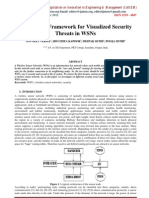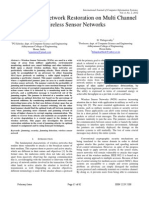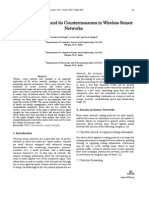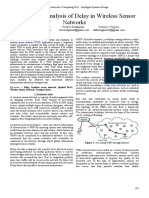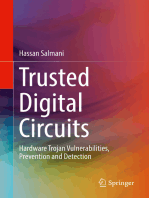Detection of Jamming Attack in Cognitive Radio Networks: C Manogna, K Bhaskar Naik
Detection of Jamming Attack in Cognitive Radio Networks: C Manogna, K Bhaskar Naik
Uploaded by
jebi.lee449Copyright:
Available Formats
Detection of Jamming Attack in Cognitive Radio Networks: C Manogna, K Bhaskar Naik
Detection of Jamming Attack in Cognitive Radio Networks: C Manogna, K Bhaskar Naik
Uploaded by
jebi.lee449Original Description:
Original Title
Copyright
Available Formats
Share this document
Did you find this document useful?
Is this content inappropriate?
Copyright:
Available Formats
Detection of Jamming Attack in Cognitive Radio Networks: C Manogna, K Bhaskar Naik
Detection of Jamming Attack in Cognitive Radio Networks: C Manogna, K Bhaskar Naik
Uploaded by
jebi.lee449Copyright:
Available Formats
International Journal of Recent Advances in Engineering & Technology (IJRAET)
________________________________________________________________________________________________
Detection of Jamming Attack in Cognitive Radio Networks
1
C Manogna, 2K Bhaskar Naik
M.Tech-CNIS, Department of CSE, Sree Vidhyanikethan Engineering College, Rangampet, Tirupati
M.Tech, Assistant Professor, Department of CSE, Sree Vidhyanikethan Engineering College, Rangampet, Tirupati
Email: 1chundurimanogna@gmail.com, 2bhaskar.cse501@gmail.com
Abstract Cognitive Radio is becoming a hot research
topic in wireless communication field now, which can be
used to alleviate the spectrum shortage problem and
improve the spectrum utilization. While Cognitive Radio
Networks (CRNs) present a promising solution to solve the
scarcity of the radio spectrum, they are still susceptible to
jamming attacks. The CRN is based on IEEE Wireless
Regional Area Network (WRAN). The attacker may be
external users or secondary users. But cognitive network is
sensitive to security threats. A secondary user in the CRN
to quickly detect the attack, by simple yet effective
detection method is presented.. To overcome jamming
attack issues proposed detection method can be used, to
find the abnormal behavior of the system. It can adopt the
anomaly detection approach and use non-parametric
cumulative sum (cusum) as a change point detection
algorithm to discover the jamming attack in the system.
Index Terms Jamming Attack,
Network, Intrusion Detection System.
Cognitive
Radio
I. INTRODUCTION
Recently, the explosive growth of wireless services and
The research work presented in [2] pioneered in
addressing the need of IDS for CRNs as a second line of
intrusion/attack detection in addition to the conventional
cryptographic primitives for facilitating authentication
and confidentiality. Even though the work in [2] defined
some of the essential modules for designing an IDS for
CRNs, it did not focus on specifying any lightweight
detection algorithm. Having understood the lack of
research work on the IDS based defense for CRNs, we
are motivated to design an effective IDS for deployment
in the cognitive unlicensed users. The proposed IDS
uses cusum based anomaly detection, which is
lightweight and is able to discover previously unknown
attacks with significantly low detection latency.
II. EXISTING CRN ARCHITECTURE
Considered CRN system model based on IEEE 802.22
WRAN is depicted in Fig. 1. For simplicity, the figure
includes only one television broadcasting tower whereas
multiple broadcasting towers may also be present. The
television companies have license to broadcast their
programs through the reserved band of the 54 to 806
MHz. So, the television companies (along with their
subscribers) formulate the primary users of the
system. On the other hand, the IEEE 802.22 WRAN
specification allows a number of cells, each of which
is managed by a base station (BS). The WRAN cells
form our considered CRN. The service coverage radius
of each of the WRAN cells featuring collocated CRNs
varies from 33 to 100km. Each CRN can support a
number of secondary users, who may access the
unused spaces of the spectrum, which is usually reserved
for the television companies, i.e., the primary users.
These unused spaces of the spectrum might occur due to
different scenarios, e.g., when the television broadcast is
offline/idle. The unused portions of the spectrum are
referred to as white spaces. Each secondary
applications led to a shortage of radio spectrum. Since
the Federal Communication Commission (FCC)
approved unlicensed users to access the unused portion
of the reserved spectrum (e.g., television channels) for
wireless broadband services, various researchers have
devoted a lot of effort in designing cognitive radio
networks (CRNs) to exploit this feature. CRNs are
intelligent networks, which allow unlicensed users to
use software radio for making the best use of the
available/unused spectrum. While doing so, the
unlicensed cognitive users should be transparent. In
other words, they may not interfere with the primary
users (i.e., the users for whom the system was originally
designed) in order to share the radio spectrum resource
in CRNs such as those based on IEEE 802.22 wireless
regional area network (WRAN) technology [1]. This
user is equipped with software radio to sense whether
radio spectrum sharing policy among the licensed and
the primary users are currently occupying a channel or
unlicensed users, however, opens up the possibility of
not. If the channel is occupied, the secondary user has
various security threats. Indeed, a number of attacks
the ability to intelligently adapt his radio to another
have been studied in recent literature that target CRNs.
channel in order to sense the white spaces of that
Although some solutions have been presented to detect
channel. The intelligent adaptation with the external
these attacks, to the best of our knowledge to date, a
environment is possible as the cognitive engine is able to
full-fledged intrusion detection system (IDS) has not yet
been designed for combating the attacks against CRNs.
_______________________________________________________________________________________________
ISSN (Online): 2347 - 2812, Volume-2, Issue -6,7 2014
69
International Journal of Recent Advances in Engineering & Technology (IJRAET)
________________________________________________________________________________________________
continuously learn by utilizing online and offline
learning policies.
frequency signals and do not follow underlying network
architecture. Typically, jamming attacks have been
considered under external threat model, in which
jammer is not part of network. However, adversaries
with internal knowledge of protocol and network
specification can introduce jamming attacks that are
difficult to detect and prevent.
Jamming attack: Like other wireless communication
systems, jamming attack is one of the most difficult
threats in CRNs. A jamming attacker may transmit
continuous packets to force a legitimate secondary user
to never sense an idle channel. This leads to a DoS type
attack whereby the legitimate user is unable to access
any white space.
IV. PROPOSED DETECTION SYSTEM
Figure 1 CRN Architecture
Figure 2 Radio Spectrum use in CRN
The plot in Fig. 1 demonstrates an example of
secondary users share the spectrum with the
ones over time. It is worth noting that the plot
simple illustration for ease of understanding,
white spaces are not necessarily contiguous.
how the
primary
shows a
and the
III. JAMMING ATTACK AGAINST CRN
Built upon a shared wireless medium, wireless networks
are susceptible to jamming attacks. These types of
attacks can easily be accomplished by an adversary by
either bypassing MAC layer protocol or by emitting RF
signals. Typically, jamming can be referred as
intentional interference attacks on wireless networks. It
is an attempt of making the users not possible to use
network resources. Jamming attacks are severe Denialof-service attacks against wireless medium. In this work,
considering the role of wireless adversary, which targets
the packets of high importance by emitting radio
The conventional detection methods usually follow
either mis-use or anomaly based attack detection
methods. The mis-use based detection method uses
signatures of already known attacks. However, the misuse based approach cannot discover new types of attacks
effectively. On the other hand, as its name implies, the
anomaly based detection methodology relies on nding
the anomaly, which represents an abnormal mode of
operation in the system. By designing an appropriate
anomaly based intrusion/attack detection system, it may
be possible to detect new (i.e., not known beforehand)
attacks, which generate some abnormal change in the
targeted CRN. This is the reason why it is better to use
the anomaly based intrusion detection technique in the
IDS for identifying attacks in CRNs. It is worth
mentioning that some of our earlier works employed a
variety of statistical detection techniques for different
types of wireless networks. However, many of the
existing statistical detection techniques may not be
adequate for designing an IDS for CRN as it presents a
unique challenge. Specically in CRN, a centralized IDS
may not be able to detect a jamming attack and notify
the secondary users quick enough, and therefore, it is
important to facilitate lightweight yet effective IDSs in
the secondary users themselves. Toward this end, in the
following, we present our anomaly based IDS, which
utilizes time-series cumulative sum (cusum) hypothesis
testing [7]. The reason behind choosing cusum for our
proposed detection engine is due to its low complexity
and overhead. As a consequence, the IDS can be
lightweight and deployed in the individual secondary
users. Note that such IDS deployment does not conict
with the regulation of the FCC that prohibits changing
primary user systems [4]. As mentioned earlier, each
secondary user is assumed to have an IDS. The IDS
operates in two steps, namely learning or proling phase
and detection phase. In the remainder of this section, we
describe these two phases in detail.
A. Learning phase
To effectively detect anomalies due to various types of
attacks, the IDS needs to be designed in such a fashion
that it may learn the normal behavior of protocol
_______________________________________________________________________________________________
ISSN (Online): 2347 - 2812, Volume-2, Issue -6,7 2014
70
International Journal of Recent Advances in Engineering & Technology (IJRAET)
________________________________________________________________________________________________
operation, trafc ow, primary user access time, packet
delivery ratio (PDR), signal strength (SS), and so forth.
The IDS may learn these information by constructing a
statistical prole during normal CRN conditions or with
acceptable (i.e., low) level of suspicious activities. To
make it clear to the readers, an example of a physical
layer attack, i.e., the jamming attack, is considered for
our study. In order to identify the jamming attack, let us
consider a simple observation made by a secondary user
involving its PDR and SS. The PDR of a user indicates
the ratio of the number of packets received by the user to
that of the packets sent to him. Note that while this is an
example case of the IDS learning phase (which arises
from a specic jamming attack against the CRN), our
IDS is not limited to learning this feature only. In fact, if
the IDS is appropriately designed by taking into
consideration the CRN system specications, wireless
protocol behavior, and so forth, it can learn various
modes of operation of the CRN. The acquired
information can facilitate the detection phase of the IDS
to discover unknown intrusions or attacks against the
targeted CRN.
Yn = (Yn1 + Gn)+; Y0 = 0 ----->(1)
where x+ = x if x > 0; otherwise, x+ = 0.
A large value of Yn strongly implies an anomaly (i.e.,
the effect of jamming attack in this case). The detection
threshold, is computed as follows.
= (m )tdes ------->(2)
where tdes denotes the desired detection time, which
should set to a small value for quickly detecting an
anomaly. At the detection phase, the IDS computes Yn
over time. Yn remains close to zero as long as normal
conditions prevail in the CRN. Upon a jamming attack,
Yn starts to increase. When Yn exceeds and as long as
the SS measured at the secondary user is high, the IDS
generates an alert of a possible attack (i.e., jamming).
This is illustrated in Fig. 5.
B. Detection phase
The proposed IDS detection phase relies on nding the
point of change in the CRN operation as quickly as
possible under an attack. First, let us present a physical
layer jamming attack a follows. When a malicious user
jams a secondary users connection, the following
observations can be made. While the SS measured at
that secondary user remains high, his PDR usually
drops. This happens because the secondary user never
receives some/all of the packets sent to him. Our point
of interest is how to detect the change point in the PDR
behavior of a secondary user (targeted by a jamming
attacker).
Figure 3: Computing Fn and Mean of Fn
In other words, how can the IDS find when the PDR of
the Secondary user is dropping significantly enough to
reflect the impact of a jamming attack? In the following,
our proposed IDS with cusum based anomaly detection
is presented to deal with this issue.
Assume that the IDS operates over equal time-rounds,
n (Where n = 1, 2, 3, ...). Let the mean of Fn during
the profiling period (i.e., no or low jamming attack
scenario) be represented by m. The idea is that the IDS
continues to monitor a significant change in the value of
m that can be considered as the influence of the
jamming attack. m remains close to one until an
anomaly occurs (which is later shown in Fig. 3).
However, an assumption of the nonparametric cusum
algorithm suggests that the mean value of the random
sequence should be negative during the normal
conditions and becomes positive upon a change.
Therefore, a new sequence Gn = Fn is obtained
where is the average of the minimum/negative peak
values of Fn during the profiling period (as shown in
Fig. 4). During a jamming attack, the increase in the
mean of Gn can be lower bounded by h = (2). Then, the
cusum sequence Yn is expressed as follows.
Figure 4: Computing Gn and Mean of Gn
Figure 5: Computing cusum sequence, Yn
_______________________________________________________________________________________________
ISSN (Online): 2347 - 2812, Volume-2, Issue -6,7 2014
71
International Journal of Recent Advances in Engineering & Technology (IJRAET)
________________________________________________________________________________________________
V. CONCLUSIONS
Jamming attack is one of the most dangerous attacks in
CRNs. In this paper, proposed a simple yet effective
detection method, which can be easily implemented in
the secondary users cognitive radio software. The
proposed method uses non-parametric cusum algorithm,
which offers anomaly detection. By learning the normal
mode of operations and system parameters of a CRN,
the proposed IDS is able to detect suspicious (i.e.,
anomalous or abnormal) behavior arising from a
jamming attack. In future, this work will perform further
investigations on how to enhance the detection
sensitivity of the IDS.
[4]
W. El-Hajj, H. Safa, and M. Guizani, Survey of
Security Issues in Cognitive Radio Networks,
Journal of Internet Technology (JIT), vol. 12, no.
2, pp.181-198, Mar. 2011.
[5]
S. Kurosawa, H. Nakayama, N. Kato, A.
Jamalipour, and Y. Nemoto, Detecting
Blackhole Attack on AODV-based Mobile Ad
Hoc Networks by Dynamic Learning Method,
International Journal of Network Security, Vol. 5,
No. 3, pp. 338-346, Nov. 2007.
[6]
B. Kannhavong, H. Nakayama, Y. Nemoto, N.
Kato, and A Jamalipour, A Survey of Routing
Attacks in Mobile Ad Hoc Networks, IEEE
Wireless Communications, vol. 14, no. 5, 85-91,
Oct. 2007.
[7]
Z. M. Fadlullah, T. Taleb, A. Vasilakos, M.
Guizani, and N. Kato, DTRAB: Combating
Against Attacks on Encrypted Protocols Through
Traffic-Feature
Analysis,
IEEE/ACM
Transactions on Networking, vol. 18, no. 4, pp.
1234-1247, Aug. 2010.
[8]
K. Ju and K. Chung, Jamming Attack Detection
and Rate Adaptation Scheme for IEEE 802.11
Multi-hop Tactical Networks, International
Journal of Security and Its Applications, vol. 6,
no. 2, pp. 149-154, Apr. 2012.
REFERENCES
[1]
C. Cordeiro, K. Challapali, and D. Birru, IEEE
802.22: An Introduction to the First Wireless
Standard based on Cognitive Radios, Journal of
Communications, vol. 1, no. 1, pp. 38-47, Apr.
2006.
[2]
O. Leon, R. Roman, and J. H. Serrano, Towards
a Cooperative Intrusion Detection System for
Cognitive Radio Networks, in Proc. Workshop
on Wireless Cooperative Network Security
(WCNS11), Valencia, Spain, May 2011.
[3]
O. Leon, J. Hernandez-Serrano, and M. Soriano,
Securing cognitive radio networks, in
International Journal of Communication Systems,
vol. 23, no. 5, pp. 633-652, May 2010.
_______________________________________________________________________________________________
ISSN (Online): 2347 - 2812, Volume-2, Issue -6,7 2014
72
You might also like
- Code Description ValidityDocument7 pagesCode Description ValidityBrgy Baloling83% (6)
- Defense Against Primary User Emulation Attacks in Cognitive Radio NetworksDocument12 pagesDefense Against Primary User Emulation Attacks in Cognitive Radio NetworksMahwish ArifNo ratings yet
- Unit 5 - CRDocument44 pagesUnit 5 - CRYuvashri SelvamNo ratings yet
- Security Threats in Cognitive Radio: Aman KumarDocument25 pagesSecurity Threats in Cognitive Radio: Aman KumarParmodDhandaNo ratings yet
- Primary User Emulation Attack (PUEA) Analysis in Cognitive Radio NetworkDocument5 pagesPrimary User Emulation Attack (PUEA) Analysis in Cognitive Radio NetworkInternational Journal of Application or Innovation in Engineering & ManagementNo ratings yet
- Selfish Attack Detection in Cognitive Ad Hoc NetworkDocument7 pagesSelfish Attack Detection in Cognitive Ad Hoc NetworkEditor IJRITCCNo ratings yet
- Security and Privacy of Collaborative Spectrum Sensing in Cognitive Radio NetworksDocument15 pagesSecurity and Privacy of Collaborative Spectrum Sensing in Cognitive Radio NetworksVăn Tấn ThanhNo ratings yet
- Literature SurveyDocument3 pagesLiterature SurveyAshok KumarNo ratings yet
- Welcome To International Journal of Engineering Research and Development (IJERD)Document8 pagesWelcome To International Journal of Engineering Research and Development (IJERD)IJERDNo ratings yet
- Security Threats in Military Cognitive RadioDocument10 pagesSecurity Threats in Military Cognitive RadioAbrar AhmadNo ratings yet
- Security Model For Cognitive Radio Networks: Sudan University of Science and Technology College of Graduate StudiesDocument20 pagesSecurity Model For Cognitive Radio Networks: Sudan University of Science and Technology College of Graduate StudiesMutaz AwadNo ratings yet
- Book Chapter 6Document26 pagesBook Chapter 6Jihen BennaceurNo ratings yet
- Analysis of Various Spectrum Sensing Techniques in Cognitive RadioDocument5 pagesAnalysis of Various Spectrum Sensing Techniques in Cognitive RadioSaiKishoreNo ratings yet
- Securing Cognitive Radio Networks: O. Le On, J. Hern Andez-Serrano and M. SorianoDocument20 pagesSecuring Cognitive Radio Networks: O. Le On, J. Hern Andez-Serrano and M. Sorianosuchi87No ratings yet
- International Journal of Engineering Research and Development (IJERD)Document7 pagesInternational Journal of Engineering Research and Development (IJERD)IJERDNo ratings yet
- Analysis of Security Protocols in Wireless Sensor Network: Ritu Sharma Yogesh ChabaDocument7 pagesAnalysis of Security Protocols in Wireless Sensor Network: Ritu Sharma Yogesh ChabaHiran VNNo ratings yet
- A Feasible Theoretical Approach On Attainment of Malicious Attacks in Wireless Sensor NetworksDocument9 pagesA Feasible Theoretical Approach On Attainment of Malicious Attacks in Wireless Sensor NetworksRakeshconclaveNo ratings yet
- Simulink Cognitive Radio 1Document8 pagesSimulink Cognitive Radio 1bebisekitNo ratings yet
- Adversary Detection in Wireless Sensor Networks Under Byzantine AttacksDocument3 pagesAdversary Detection in Wireless Sensor Networks Under Byzantine AttackserpublicationNo ratings yet
- A Proposed Framework For Visualized Security Threats in WsnsDocument6 pagesA Proposed Framework For Visualized Security Threats in WsnsInternational Journal of Application or Innovation in Engineering & ManagementNo ratings yet
- Research Article: Tool For Recovering After Meteorological Events Using A Real-Time Rem and Iot Management PlatformDocument14 pagesResearch Article: Tool For Recovering After Meteorological Events Using A Real-Time Rem and Iot Management PlatformpradiptamNo ratings yet
- Cognitive Spectrum Sensing Techniques A Brief ReviewDocument4 pagesCognitive Spectrum Sensing Techniques A Brief ReviewEditor IJRITCCNo ratings yet
- Ijset 2014 802Document5 pagesIjset 2014 802Editorijset IjsetNo ratings yet
- Ijret20150414004 PDFDocument4 pagesIjret20150414004 PDFManoj VarmaNo ratings yet
- Jamming and Network Restoration On Multi Channel Wireless Sensor NetworksDocument5 pagesJamming and Network Restoration On Multi Channel Wireless Sensor NetworksRakeshconclaveNo ratings yet
- Art:10.1007/s11277 011 0243 5Document11 pagesArt:10.1007/s11277 011 0243 5suchi87No ratings yet
- Channels Reallocation in Cognitive Radio Networks Based On DNA Sequence AlignmentDocument12 pagesChannels Reallocation in Cognitive Radio Networks Based On DNA Sequence AlignmentijngnNo ratings yet
- An Overview of Cognitive Radio Architecture A Review: S.Venkateswari, R.MuthaiahDocument6 pagesAn Overview of Cognitive Radio Architecture A Review: S.Venkateswari, R.MuthaiahAnonymous 1aqlkZNo ratings yet
- A New Hybrid Cryptography Technique in Wireless Sensor NetworkDocument20 pagesA New Hybrid Cryptography Technique in Wireless Sensor NetworkajithNo ratings yet
- Cognitive Radio PresentationDocument37 pagesCognitive Radio Presentationgantayat0% (1)
- Cognitive Radio Networks: Seminar Report OnDocument35 pagesCognitive Radio Networks: Seminar Report OnsharvikjNo ratings yet
- 2024 Localization in Wireless Sensors NetworkDocument51 pages2024 Localization in Wireless Sensors NetworknithyadheviNo ratings yet
- Literature Survey by M.arunprabu (Mitigation of Control Channel Jamming)Document8 pagesLiterature Survey by M.arunprabu (Mitigation of Control Channel Jamming)arunprabu123No ratings yet
- Cognitive Radio Networks: Rahul Chumble & S. S. GundalDocument8 pagesCognitive Radio Networks: Rahul Chumble & S. S. Gundalvsayyap1No ratings yet
- Selfish Jammer Detection in Multiple P2P Communication NetworksDocument7 pagesSelfish Jammer Detection in Multiple P2P Communication Networksmindworkz proNo ratings yet
- 1spectrum Sensing - pdf1Document10 pages1spectrum Sensing - pdf1shashi kantNo ratings yet
- Survey On Software Task Extraction and NavigationDocument6 pagesSurvey On Software Task Extraction and NavigationEditor IJRITCCNo ratings yet
- Cognitive Spectrum Framework On Cooperative Environment: A StudyDocument6 pagesCognitive Spectrum Framework On Cooperative Environment: A StudyGayathri K MNo ratings yet
- Attacks & Preventions of Cognitive Radio Network-A SurveyDocument5 pagesAttacks & Preventions of Cognitive Radio Network-A SurveySandeep TewariNo ratings yet
- Intrusion Detection in Mobile Ad Hoc Networks ThesisDocument7 pagesIntrusion Detection in Mobile Ad Hoc Networks Thesisvaj0demok1w2100% (1)
- A Review: Wireless Sensor Networks and Its Application, Platforms, Standards and ToolsDocument7 pagesA Review: Wireless Sensor Networks and Its Application, Platforms, Standards and ToolsseventhsensegroupNo ratings yet
- Ijcet: International Journal of Computer Engineering & Technology (Ijcet)Document8 pagesIjcet: International Journal of Computer Engineering & Technology (Ijcet)IAEME PublicationNo ratings yet
- Hello Flood Attack and Its Countermeasures in Wireless Sensor NetworksDocument5 pagesHello Flood Attack and Its Countermeasures in Wireless Sensor NetworksIJCSI EditorNo ratings yet
- Wireless Sensor Networks Modeling and Simulation in VisualsenseDocument4 pagesWireless Sensor Networks Modeling and Simulation in Visualsensevenkatdurga1962004No ratings yet
- Cognitive Radio PresentationDocument37 pagesCognitive Radio Presentationsangeetha_n100% (6)
- An Efficient Neighbor Discovery Approach Using HTTA Sequence Based Channel Rendezvous in CRNDocument11 pagesAn Efficient Neighbor Discovery Approach Using HTTA Sequence Based Channel Rendezvous in CRNInternational Journal of Innovative Science and Research TechnologyNo ratings yet
- A Survey of Detection and Mitigation Techniques of Primary User Emulation Attacks in Cognitive Radio Networks PDFDocument9 pagesA Survey of Detection and Mitigation Techniques of Primary User Emulation Attacks in Cognitive Radio Networks PDFHasan AljabaliNo ratings yet
- Review On Resource Efficient Relay Selection Scheme For Cognitive Radio NetworkDocument6 pagesReview On Resource Efficient Relay Selection Scheme For Cognitive Radio NetworktheijesNo ratings yet
- Performance Analysis of Delay in Wireless Sensor Networks: Jayashree C. Pasalkar Vivek S. DeshpandeDocument4 pagesPerformance Analysis of Delay in Wireless Sensor Networks: Jayashree C. Pasalkar Vivek S. Deshpandeteferi kassaNo ratings yet
- Jelly FishDocument15 pagesJelly FishgomathiNo ratings yet
- 14 1474953582 - 27-09-2016 PDFDocument3 pages14 1474953582 - 27-09-2016 PDFEditor IJRITCCNo ratings yet
- ERFLA Camera Ready Final-ColomboDocument6 pagesERFLA Camera Ready Final-ColomboKalyanNo ratings yet
- Secure and Efficient Defense Strategy Against Energy Exhausting Attacks in WSNDocument4 pagesSecure and Efficient Defense Strategy Against Energy Exhausting Attacks in WSNijcnesNo ratings yet
- Implementation of Spectrum Detection Techniques in Cognitive RadioDocument5 pagesImplementation of Spectrum Detection Techniques in Cognitive RadioIJRASETPublicationsNo ratings yet
- Adhoc and Wireless Sensor NetworksDocument52 pagesAdhoc and Wireless Sensor Networkskumar27sahilNo ratings yet
- Simulation and Analysis of Cognitive Radio System Using MatlabDocument16 pagesSimulation and Analysis of Cognitive Radio System Using MatlabOral RobertzNo ratings yet
- Thesis On Wormhole Attack in ManetDocument8 pagesThesis On Wormhole Attack in Manetaprilwbndsouthbend100% (2)
- Enhancement in Elimination of Security Threads Using Trusted Proactive RoutingDocument7 pagesEnhancement in Elimination of Security Threads Using Trusted Proactive RoutingInternational Organization of Scientific Research (IOSR)No ratings yet
- Cognitive RadioDocument11 pagesCognitive RadioAn An100% (1)
- Trusted Digital Circuits: Hardware Trojan Vulnerabilities, Prevention and DetectionFrom EverandTrusted Digital Circuits: Hardware Trojan Vulnerabilities, Prevention and DetectionNo ratings yet
- Convergence of Mobile and Stationary Next-Generation NetworksFrom EverandConvergence of Mobile and Stationary Next-Generation NetworksNo ratings yet
- B.E. Electronics (VLSI Design and Tech)Document271 pagesB.E. Electronics (VLSI Design and Tech)jebi.lee449No ratings yet
- GazetteDocument3 pagesGazettejebi.lee449No ratings yet
- (Please Refer PG (Full Time) R-2013 of Affiliated Institutions For Syllabus)Document2 pages(Please Refer PG (Full Time) R-2013 of Affiliated Institutions For Syllabus)jebi.lee449No ratings yet
- Xspice Users Manual PDFDocument249 pagesXspice Users Manual PDFjebi.lee449No ratings yet
- Level & Context Knowledge:: Hand Out For Question Paper SettingDocument4 pagesLevel & Context Knowledge:: Hand Out For Question Paper Settingjebi.lee449No ratings yet
- Zinc Vegetarian NutritionDocument2 pagesZinc Vegetarian Nutritionjebi.lee449No ratings yet
- ABC#EDocument1 pageABC#Ejebi.lee449No ratings yet
- Cognitive Radio: Brain-Empowered Wireless Communcations: Matt Yu, EE360 Presentation, February 15 2012Document22 pagesCognitive Radio: Brain-Empowered Wireless Communcations: Matt Yu, EE360 Presentation, February 15 2012jebi.lee449No ratings yet
- Ap7301 Electromagnetic Interference and Compatibility L T P CDocument2 pagesAp7301 Electromagnetic Interference and Compatibility L T P Cjebi.lee449No ratings yet
- 1st Grade LoudDocument3 pages1st Grade Loudapi-280142822No ratings yet
- PL 1 - Mau Ke Hoach Day Hoc Cua To Chuyen Mon - TA7 Global SuccessDocument11 pagesPL 1 - Mau Ke Hoach Day Hoc Cua To Chuyen Mon - TA7 Global SuccessĐờEnĐen100% (1)
- Practical ComputingDocument2 pagesPractical Computingapi-334967417No ratings yet
- Advertising Ethics and Viewers Perception Towards Surrogate AdvertisingDocument66 pagesAdvertising Ethics and Viewers Perception Towards Surrogate AdvertisingSrijith ShivanNo ratings yet
- An Introduction To HPLC For Pharmaceutical Analysis Oona McpolinDocument3 pagesAn Introduction To HPLC For Pharmaceutical Analysis Oona McpolinOmar Cruz Ilustración0% (2)
- Idp Prof Ed 105 Bsed Sci IaDocument5 pagesIdp Prof Ed 105 Bsed Sci IaAce ManicaoNo ratings yet
- Introduction To Error Control CodingDocument32 pagesIntroduction To Error Control Codingwangshu421No ratings yet
- ILW1501 - Tutorial Letter 101 - 2022 - 3 - BDocument13 pagesILW1501 - Tutorial Letter 101 - 2022 - 3 - BJaredNo ratings yet
- Lesson Plan Math and ReflectionDocument10 pagesLesson Plan Math and ReflectionHessa MohammedNo ratings yet
- Lesson PlanDocument4 pagesLesson Planapi-274283536No ratings yet
- Remedial TeachingDocument12 pagesRemedial TeachingNiKen LarasatiNo ratings yet
- JNTUA R20 B.Tech EEE III IV Course Structure SyllabusDocument111 pagesJNTUA R20 B.Tech EEE III IV Course Structure Syllabuskurubamailagani ravaliNo ratings yet
- Session 4.2 Modelling of The IBL and 5es Teaching CycleDocument23 pagesSession 4.2 Modelling of The IBL and 5es Teaching CycleJesse James C. AragonesNo ratings yet
- Linkin WordsDocument3 pagesLinkin WordsUmut AlıntaşNo ratings yet
- Afsal M-C FinalDocument14 pagesAfsal M-C FinalJabir AngillathNo ratings yet
- Jelks Soto Leon Report 3 2Document49 pagesJelks Soto Leon Report 3 2api-351301989No ratings yet
- Speaking 2 Lesson 13 Speaking CardsDocument4 pagesSpeaking 2 Lesson 13 Speaking CardsNguyễn Huỳnh A. QuốcNo ratings yet
- Bengali Grammar 2 (Ingles) PDFDocument152 pagesBengali Grammar 2 (Ingles) PDFRamanuya097No ratings yet
- Rubrica Correccion Story PETDocument1 pageRubrica Correccion Story PETHayleyNo ratings yet
- DM L1 V1 What Is Digital Marketing PDFDocument2 pagesDM L1 V1 What Is Digital Marketing PDFAksh JainNo ratings yet
- Suelto - Instructional MethodsDocument38 pagesSuelto - Instructional MethodsChristina Paule GordolanNo ratings yet
- Cody A. Mccall: September 2016-May 2017Document1 pageCody A. Mccall: September 2016-May 2017api-511395795No ratings yet
- Q2 W7 Late To PassDocument6 pagesQ2 W7 Late To Passaljohn anticristoNo ratings yet
- BHHM17Document216 pagesBHHM17EyaminNo ratings yet
- TS Provisioning R61S13Document310 pagesTS Provisioning R61S13lanmaki4398No ratings yet
- Teaching Young LearnersDocument7 pagesTeaching Young LearnersHakima BotirovaNo ratings yet
- 10 Best Ways To Write A Speech - IGCSE EnglishDocument7 pages10 Best Ways To Write A Speech - IGCSE EnglishTanakha MaziwisaNo ratings yet
- Pembelajaran Menulis Cerita Fantasi Menggunakan Model Project Based LearningDocument6 pagesPembelajaran Menulis Cerita Fantasi Menggunakan Model Project Based LearningFania NurtrianaNo ratings yet
- URBAN DESIGN - Rejuvenating The Space - Mayuresh Desai - ArchinectDocument6 pagesURBAN DESIGN - Rejuvenating The Space - Mayuresh Desai - ArchinectliuelNo ratings yet



















